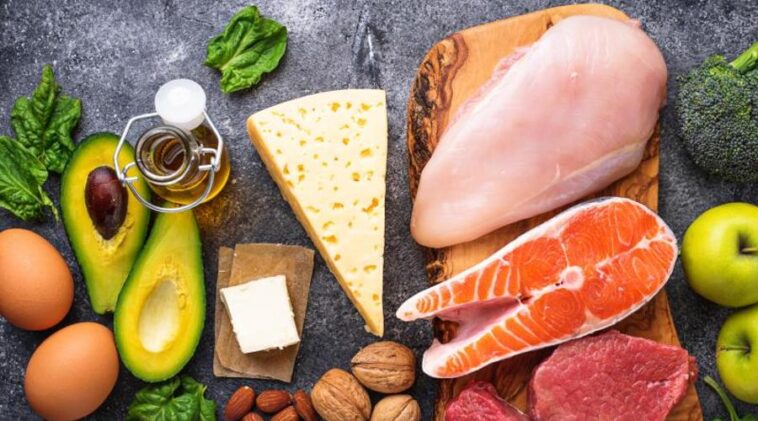The Modified Atkins Diet (MAD) is a low-carbohydrate, high-fat diet that has gained popularity in recent years as a potential treatment for epilepsy and other neurological disorders. Unlike traditional ketogenic diets, the MAD allows for more flexibility in terms of food choices and daily carbohydrate intake. If you’re interested in trying the MAD, you might be wondering what a sample menu could look like.
In this post, we’ll provide you with some ideas for breakfast, lunch, dinner, and snacks that are MAD-friendly and delicious. Whether you’re a newbie to the MAD or a seasoned pro, you’re sure to find some inspiration for your next meal.

What is the Modified Atkins Diet?
The Modified Atkins Diet (MAD) is a low-carb, high-fat diet that was originally developed for the treatment of epilepsy, but has gained popularity as a weight loss and overall health improvement diet. Unlike the classic Atkins Diet, the Modified Atkins Diet doesn’t emphasize protein intake and allows for a higher fat intake.
Benefits and Risks of the Modified Atkins Diet
The Modified Atkins Diet has been shown to have several potential benefits, including weight loss, improved blood sugar control, and a reduction in seizures in those with epilepsy. Additionally, because the diet is high in healthy fats, it may also have positive effects on cholesterol levels and overall heart health. However, the diet can be challenging to follow and may not be suitable for everyone, especially those with certain medical conditions.
Benefits of the Modified Atkins Diet:
- Promotes weight loss
- Improves blood sugar control
- Reduces seizures in those with epilepsy
- May improve cholesterol levels and heart health
Risks of the Modified Atkins Diet:
- Can be difficult to follow
- May not be suitable for individuals with certain medical conditions, such as liver or kidney disease
- May increase risk of nutrient deficiencies if not properly balanced
How the Modified Atkins Diet Differs from Other Low-Carb Diets
While the Modified Atkins Diet shares similarities with other low-carb diets, such as the ketogenic diet and the classic Atkins Diet, there are some key differences. For example, the Modified Atkins Diet allows for a higher protein intake than the ketogenic diet, but restricts carbohydrate intake to a similar degree. Additionally, the Modified Atkins Diet does not require the use of urine or blood testing to measure ketone levels, as is often required on the ketogenic diet.
Differences between the Modified Atkins Diet and other low-carb diets:
- Allows for a higher protein intake than the ketogenic diet
- Restricts carbohydrate intake to a similar degree as the ketogenic diet
- Does not require urine or blood testing to measure ketone levels, as is required on the ketogenic diet
Who Should Consider the Modified Atkins Diet?
The Modified Atkins Diet may be beneficial for a variety of individuals, including those looking to lose weight, improve blood sugar control, or reduce seizures in those with epilepsy. However, the diet may not be suitable for everyone, and it is important to consult with a healthcare provider before starting any new diet. Additionally, individuals with certain medical conditions, such as liver or kidney disease, may need to modify the diet or avoid it altogether.
Who may benefit from the Modified Atkins Diet:
- Those looking to lose weight
- Individuals with type 2 diabetes looking to improve blood sugar control
- Individuals with epilepsy looking to reduce seizures
- Individuals looking to improve cholesterol levels and heart health
Who may not be suitable for the Modified Atkins Diet:
- Individuals with certain medical conditions, such as liver or kidney disease
- Pregnant or breastfeeding women
- Children under the age of 2

Designing a Modified Atkins Diet Sample Menu
Designing a modified Atkins diet sample menu is crucial for those who want to follow this specific type of low-carb diet. It is important to consider macronutrient ratios, as well as the types of foods to include and avoid. Careful planning and preparation can help individuals achieve their weight loss and health goals while maintaining a balanced and nutritious diet. Creating a menu plan can also help individuals stay on track with their diet and reduce the risk of falling back into unhealthy eating habits. With a variety of options for breakfast, lunch, dinner, and snacks, following a modified Atkins diet can be both enjoyable and sustainable.
Macronutrient Ratios for the Modified Atkins Diet
The Modified Atkins Diet is a high-fat, low-carbohydrate, and moderate-protein diet that involves restricting carbohydrates to a maximum of 10-20 grams per day. This allows the body to enter a state of ketosis, where it burns fat for fuel instead of glucose. To achieve this, the diet typically consists of 70-80% calories from fat, 10-20% from protein, and 5-10% from carbohydrates. This macronutrient ratio can be adjusted based on individual needs and goals, but it’s important to work with a healthcare provider or registered dietitian to ensure proper nutrient intake and monitoring.
Some examples of foods that fit into the Modified Atkins Diet macronutrient ratios include:
- Healthy fats: avocado, olive oil, coconut oil, nuts and seeds, butter, cheese, fatty fish
- Protein sources: meat, poultry, fish, eggs, tofu, tempeh
- Low-carbohydrate vegetables: leafy greens, broccoli, cauliflower, zucchini, bell peppers, mushrooms
Foods to Include and Avoid on the Modified Atkins Diet
The Modified Atkins Diet focuses on consuming whole, nutrient-dense foods while limiting processed and high-carbohydrate foods. Some foods that are encouraged on the diet include:
- Healthy fats: avocado, olive oil, coconut oil, nuts and seeds, butter, cheese, fatty fish
- Protein sources: meat, poultry, fish, eggs, tofu, tempeh
- Low-carbohydrate vegetables: leafy greens, broccoli, cauliflower, zucchini, bell peppers, mushrooms
- Limited amount of fruits: berries, avocado, olives
- Low-carbohydrate snacks: cheese, nuts and seeds, hard-boiled eggs
Foods that should be avoided or limited on the Modified Atkins Diet include:
- Grains: bread, pasta, rice, cereal
- Sugar: candy, soda, desserts
- High-carbohydrate fruits: bananas, grapes, mangoes, pineapples
- Starchy vegetables: potatoes, corn, peas, beans
- Processed foods: chips, crackers, baked goods
A Sample Menu Plan for the Modified Atkins Diet
A sample menu plan for the Modified Atkins Diet might look something like this:
- Breakfast: scrambled eggs with spinach and avocado, topped with cheese
- Snack: handful of mixed nuts
- Lunch: grilled chicken breast with roasted vegetables (such as bell peppers and zucchini) and a side salad with olive oil and vinegar dressing
- Snack: celery sticks with almond butter
- Dinner: baked salmon with sautéed mushrooms and garlic, served with a side of cauliflower rice
It’s important to note that the Modified Atkins Diet should be individualized and tailored to one’s specific needs and preferences. Working with a healthcare provider or registered dietitian can help create a customized meal plan that meets nutrient needs and promotes success on the diet.

Tips and Tricks for Success on the Modified Atkins Diet
When embarking on the Modified Atkins Diet, it’s important to have a plan in place to help set yourself up for success. One key strategy is to focus on meal prep and planning. This can involve prepping meals and snacks in advance, keeping healthy snacks readily available, and setting aside time each week to plan out your meals and snacks. Another important tip is to stay aware of the common challenges that may arise while on the diet, such as carb cravings or social situations that involve tempting high-carb foods.
Meal Prep and Planning Strategies
One of the keys to success on the Modified Atkins Diet is being prepared with healthy, low-carb meal options. Meal prepping and planning can help you stay on track and avoid temptation. Here are some tips for meal prep and planning on the Modified Atkins Diet:
- Choose a specific day each week to plan and prep your meals for the upcoming week.
- Use an app or website to track your daily macronutrient intake and plan meals accordingly.
- Stock up on low-carb staples like eggs, cheese, nuts, and low-carb veggies to use in meals throughout the week.
- Cook large batches of food that can be portioned out and reheated for quick and easy meals.
- Consider investing in meal prep containers to make portioning out meals easier.
Overcoming Common Challenges on the Modified Atkins Diet
Like any diet, the Modified Atkins Diet comes with its own set of challenges. Here are some common challenges you may face on the Modified Atkins Diet and how to overcome them:
- Carb cravings: Cravings for carb-heavy foods can be intense in the early stages of the diet. Combat these cravings by snacking on low-carb options like nuts, cheese, and veggies.
- Social situations: Eating out or attending social events can be challenging on the Modified Atkins Diet. Research menus ahead of time and be prepared to ask for modifications to dishes to make them low-carb.
- Constipation: Low-carb diets can sometimes lead to constipation. Increase your fiber intake by adding in more low-carb veggies and consider taking a fiber supplement.
- Fatigue: In the early stages of the diet, you may feel fatigued as your body adjusts to the new way of eating. Make sure to stay hydrated and get enough sleep, and consider adding in more healthy fats to your diet to increase energy levels.
Incorporating Exercise into Your Modified Atkins Diet Plan
Exercise is an important part of any healthy lifestyle, and it can be especially beneficial when combined with the Modified Atkins Diet. Here are some tips for incorporating exercise into your Modified Atkins Diet plan:
- Start slow: If you’re new to exercise, start with low-impact activities like walking or yoga and gradually increase intensity.
- Focus on strength training: Building muscle through strength training can help increase metabolism and burn more calories.
- Time meals around workouts: Eating a small, low-carb meal before a workout can help provide energy, while eating a protein-rich meal after a workout can aid in muscle recovery.
- Stay hydrated: Make sure to drink plenty of water before, during, and after exercise to stay hydrated and maintain electrolyte balance.
- Listen to your body: If you feel fatigued or dizzy during exercise, take a break or adjust the intensity.

Modified Atkins Diet Recipes and Meal Ideas
The Modified Atkins Diet requires a lot of planning and meal preparation, which can be daunting at first. However, with a little creativity and the right recipes, following this diet can be both delicious and satisfying. Here are some ideas for each meal of the day to help you get started on your Modified Atkins Diet journey:
Breakfast Ideas for the Modified Atkins Diet
- Breakfast burrito bowls with scrambled eggs, avocado, spinach, and salsa
- Almond flour pancakes topped with sugar-free syrup and berries
- Bacon and mushroom frittata with a side of fresh berries
Lunch and Dinner Recipes for the Modified Atkins Diet
- Cauliflower crust pizza with low-carb tomato sauce, mozzarella cheese, and your choice of toppings
- Grilled chicken with a side of roasted broccoli and cauliflower rice
- Baked salmon with a side of zucchini noodles and garlic butter sauce
Snack and Dessert Ideas for the Modified Atkins Diet
- Guacamole with celery sticks for dipping
- Bacon-wrapped asparagus spears
- Keto-friendly cheesecake made with almond flour crust and cream cheese filling
By incorporating these recipes and meal ideas into your Modified Atkins Diet plan, you can enjoy a variety of tasty and satisfying meals throughout the day.
FAQ
The Modified Atkins Diet is generally considered safe for most people. However, it’s important to consult with a healthcare professional before starting any new diet, especially if you have a pre-existing medical condition or are taking medication.
The Modified Atkins Diet typically limits carb intake to 20-30 grams per day, but it’s important to work with a healthcare professional to determine the appropriate carb intake for your individual needs.
Yes, dairy is allowed on the Modified Atkins Diet as long as it fits within your daily carb allowance.
The Modified Atkins Diet can be adapted to suit a vegetarian or vegan diet, but it may require more planning and effort to meet your nutritional needs.
Fruits are generally limited on the Modified Atkins Diet due to their high carb content. However, small amounts of low-carb fruits like berries may be incorporated into the diet in moderation.




